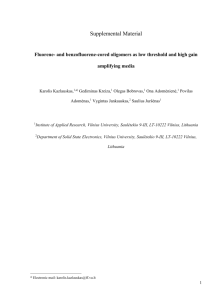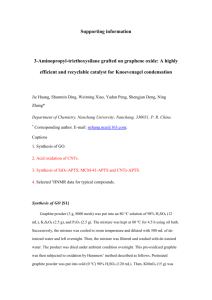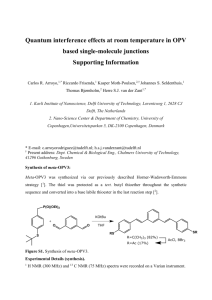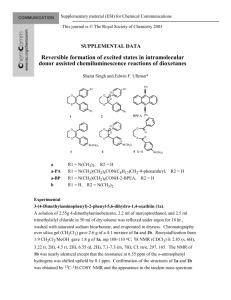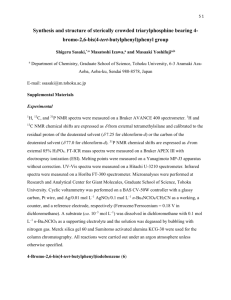Prepartion of the MacMillan Imidazolidinones
advertisement
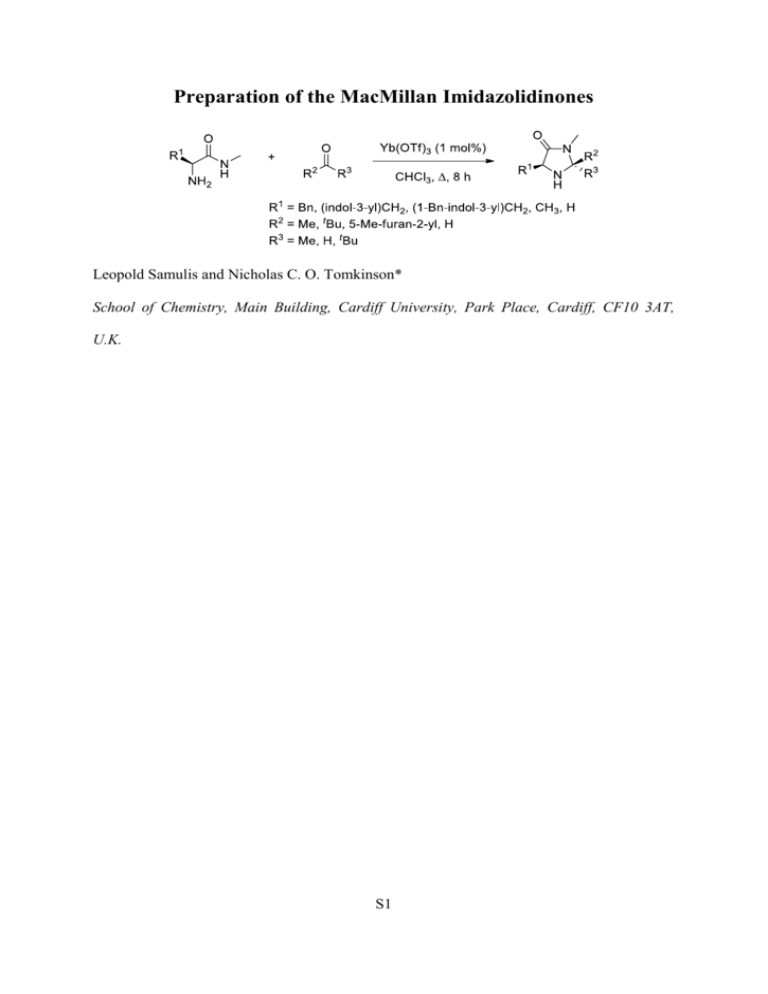
Preparation of the MacMillan Imidazolidinones Leopold Samulis and Nicholas C. O. Tomkinson* School of Chemistry, Main Building, Cardiff University, Park Place, Cardiff, CF10 3AT, U.K. S1 Preparation of the MacMillan Imidazolidinones Leopold Samulis and Nicholas C. O. Tomkinson* School of Chemistry, Main Building, Cardiff University, Park Place, Cardiff, CF10 3AT, U.K. tomkinsonnc@cardiff.ac.uk TEL: +44(0)2920874068 FAX: +44(0)2920874030 ___________________________________________________________________________ ________ Abstract: A general method for the preparation of the MacMillan imidazolidinones is described. Treatment of an α-amino amide with a carbonyl compound in refluxing chloroform in the presence of Yb(OTf)3 (1 mol%) provides convenient access to the corresponding imidazolidinones. ___________________________________________________________________________ ________ S2 Introduction Over the past decade imidazolidinones have been shown to provide an efficient platform for the acceleration of iminium ion, enamine, and SOMO catalysed processes. i,ii From this privileged structure seven principal imidazolidinone catalysts have been reported (1–7) (Figure 1). Figure 1. Principal imidazolidinone catalysts for iminium ion, enamine, and SOMO catalysed transformations. Catalyst 1 is used for cycloadditioniii and closed transition state conjugate addition reactionsiv of -unsaturated aldehydes along with several enamine catalysed processes.v,vi Catalyst 2 is the most broad ranging scaffold and is effective for cycloaddition,vii conjugate addition,viii enamineix and SOMOx catalysis. Catalyst 3 is efficient for reactions of -unsaturated ketones that proceed via iminium ion intermediates, expanding the substrate scope of known transformations to encompass this important functionality.xi Tryptophan based catalysts (e.g. 4 and 5) provide a similar reactivity profile to the phenyl alanine derived catalysts and in S3 certain cases have resulted in higher levels of enantioselectivity.xii More recently, the imidazolidinones 6 and 7 have been introduced for SOMO catalysed transformations.xiii Literature methods for the preparation of the imidazolidinones 1–3 are outlined in Scheme 1. Catalyst 1 is made by condensation of acetone (9) with amide 8 using p-toluene sulfonic acid as the catalyst.iii It has been reported that with alternative ketone and aldehyde substrates, Brønsted acid catalysed methods and elevated temperatures lead to racemisation, limiting the applicability of this method.xiv For the alternative imidazolidinones it is necessary to use Lewis acid catalysis. The pivaldehyde derived catalyst 2 is prepared from the same amide 8 using iron(III) chloride as the Lewis acid (23%).viiib The furan containing catalyst 3 is far more challenging to prepare using air sensitive samarium(III) triflate, freshly distilled aldehyde 11 and glove box techniques.xia Alternative methods for the preparation of imidazolidinones are available, the most broad ranging being the two-step procedure developed by Seebach.xv Scheme 1. Literature methods for the synthesis of 1–3. Given the importance of 1–7 and the possibility that further structural modification may lead to innovation and discovery we sought to develop a standard, robust method for their S4 preparation. Within this paper we describe a simple and scalable protocol for the preparation of the imidazolidinone architecture. S5 Results and Discussion Our investigations began with a broad survey of both Lewis and Brønsted acid catalysts to promote the formation of imidazolidinone 2 using conductive and microwave heating. From these screens the optimal method emerged to be that shown in Scheme 2. Treatment of amide 8 with 2 equivalents of pivaldehyde (10) in the presence of Yb(OTf)3 (1 mol%) gave the diastereomeric imidazolidinones 2 and 12 in approximately a 1:2 ratio. These diastereoisomers could easily be separated by chromatography to give the desired catalyst 2 (22%, >99% e.e.). Recycling of the undesired diastereoisomer 12 was also possible (1 mol% Yb(OTf)3, CHCl3, ), providing 2 with a small loss of enantiopurity (26%, 98% e.e.).xvi Scheme 2. Standard method for the synthesis of 2. Application of this standard method to alternative imidazolidinones architectures (1 and 3–7) is summarised in Table 1. The first generation catalyst 1 was effectively prepared by this method in 96% isolated yield (>99% e.e.). The synthetically more challenging furan containing catalyst 3 was also accessed by this method (32%; >99% e.e.). Although this yield is lower than the literature report, glove box techniques and distillation of aldehyde precursor were not required to access target material analytically pure. In addition to the phenyl alanine based catalysts, tryptophan derived systems (e.g. 4, 26%; 5, 26%) were also accessible suggesting the method should be applicable to alternative amino acid scaffolds with equal S6 efficiency. This was further exemplified by preparation of the alanine and glycine derived imidazolidinones 6 (77%) and 7 (55%) which have recently been used for SOMO catalysis.x S7 Table 1. Application of imidazolidinone synthesis.a a Standard reaction conditions: Yb(OTf)3 (1 mol%); CHCl3 (0.5 M); ; 8 h; b Catalyst 7 prepared under standard reaction conditions from glycine N-methyl amide and pivaldehyde as a racemic mixture; c Determined by HPLC on a chiral stationary phase. See Supporting Information for full details. Confirmation of e.e. for the imidazolidinones 1–6 came from their preparation using racemic amino amide starting materials and comparison of HPLC traces (see Supporting Information for full details). In each case, the e.e. was found to be >99%, showing this to be a viable method for the preparation of imidazolidinones from a variety of amino acid and carbonyl substrates without racemisation. Finally, to confirm the robust nature of this method the second generation catalyst 2 was prepared from 5 g of amide 8. Thus, imidazolidinone 2 was prepared in 22% yield and >99% S8 e.e. (together with the recyclable diastereoisomer 12; 46%) suggesting the method should be scalable. Scheme 3. Scale up of imidazolidinone synthesis. Conclusion In summary, we have developed a standard method for synthesis of the principal MacMillan imidazolidinones 1–7 that have demonstrated widespread use in LUMO, HOMO and SOMO accelerated transformations. The reactions are scalable and proceed without loss of optical purity. In certain cases, the current method offers distinct operational advantages over literature procedures and importantly, provides a standard protocol to prepare the structures. The methodology should be applicable to alternative carbonyl substrates and provide opportunity to diversify the known scaffolds, providing the impetus for further development in this exciting and important area of contemporary research. Experimental Section Commercially available solvents and reagents were used without further purification. Petroleum ether refers to the fraction with bp 40–60 °C and ether refers to diethyl ether. Flash chromatography was carried out using Merck Kieselgel 60 H silica or Matrex silica 60. Analytical thin layer chromatography was carried out using aluminium-backed plates coated with Merck Kieselgel 60 GF254 that were visualised under UV light (at 254 and/or 360 nm). Infra-red (IR) spectra were recorded in the range 4000–600 cm–1 using KBr disks for solid samples and thin films between NaCl plates for liquid samples or as a nujol mull and are reported in cm–1. Nuclear magnetic resonance (NMR) spectra were recorded in CDCl3 at 18 S9 °C and were reported in ppm; J values were recorded in Hz and multiplicities were expressed by the usual conventions. Low-resolution mass spectra (MS) were determined using electrospray ionization (ES) unless otherwise stated. APCI refers to atmospheric pressure chemical ionization, CI refers to chemical ionization (ammonia) and EI refers to electron ionization. High-resolution mass spectra were obtained courtesy of the EPSRC Mass Spectrometry Service at University of Wales, Swansea, U.K. using the ionization methods specified. In vacuo refers to evaporation at reduced pressure using a rotary evaporator and diaphragm pump, followed by the removal of trace volatiles using a vacuum (oil) pump. L-Phenylalanine L-Phenylalanine N-methylamideiii ethyl ester hydrochloride (100.8 g, 439 mmol) was stirred in a 33% w/w ethanolic solution of methylamine (300 mL, 74.8 g, 2.41 mol) for 95 h. The solution was evaporated and the residue dissolved in sodium hydrogen carbonate solution (saturated, 200 mL) then extracted with chloroform (4 x 100 mL). The combined extracts were dried over sodium carbonate and evaporated to give the crude product, a white solid (52.4 g, 294 mmol, 67%). This was recrystallised from ethyl acetate : hexanes (1 : 2, 600 mL) and dried in vacuo to give the product as white crystals (42.7 g, 240 mmol, 55%); mp 58–60 °C [lit.xvii mp 92–93 °C]; [α]D34 72.6 (c 0.1, CH2Cl2); νmax (NaCl disk)/cm–1 3358, 1651, 1573, 1496, 1454, 1412; δH (500 MHz, CDCl3) δH 7.33–7.21 (6H, m, ArH and NH), 3.61 (1H, dd, J 9.5 and 4.0, COCH), 3.28 (1H, dd, J 13.7 and 4.0, CH2), 2.82 (3H, d, J 5.0, NCH3), 2.68 (1H, dd, J 13.7 and 9.5, CH2), 1.41 (2H, s, NH2); δC (125 MHz, CDCl3) 174.8 (C), 138.0 (C), 129.3 (CH), 128.7 (CH), 126.8 (CH), 56.5 (CH), 41.1 (CH2), 25.8 (CH3); m/z (ES+): 179.1 (M+H+); HRMS (ES+): found M+H+, 179.1181. C10H14N2O requires, 179.1184. L-Tryptophan N-methylamidexviii Thionyl chloride (10.0 mL, 16.3 g, 134 mmol) was added dropwise to ethanol (130 mL). The solution was cooled to room temperature before L-tryptophan (9.7 g, 47.6 mmol) was added S10 and the mixture stirred for 24 hours then evaporated. The residue was washed with ethyl acetate (1 x 300 mL, 1 x 100 mL) and petroleum ether (c.a. 100 mL) then dried to yield a cream solid. The solid was stirred in an ethanolic solution of methylamine (70 mL, 560 mmol) for 120 hours then evaporated, taken up in sodium bicarbonate (saturated, 100 mL) and extracted with chloroform (4 x 40 mL). The combined chloroform extract was dried over sodium carbonate and evaporated to yield the desired product, a yellow solid (6.1 g, 28 mmol, 59%); mp 123–125 °C; [α]D34 32.0 (c 0.1, CH3OH); νmax (NaCl disk)/cm–1 3282, 1650, 1537, 1457, 1411, 1342, 1232, 1101; δH (500 MHz, DMSO-d6) 10.89 (1H, bs, NH), 7.84– 7.83 (1H, m, NH), 7.57 (1H, d, J 8.1, ArH), 7.36 (1H, d, J 2.2, ArH), 7.17 (1H, s, ArH), 7.07 (1H, ddd, J 7.0, 7.0 and 0.9, ArH), 6.98 (1H, ddd, J 7.0, 7.0 and 0.9, ArH), 3.44 (1H, dd, J 8.1 and 4.9, COCH), 3.09 (1H, dd, J 14.1 and 4.9, CH2), 2.77 (1H, dd, J 14.1 and 8.1, CH2), 2.60 (3H, d, J 4.7, CH3), 1.70 (1H, bs, NH2); δC (125 MHz, DMSO-d6) 175.7 (C), 136.7 (C), 128.0 (C), 124.2 (CH), 121.3 (CH), 119.0 (CH), 118.7 (CH), 111.8 (CH), 111.3 (C), 56.0 (CH), 31.7 (CH2), 26.0 (CH3); m/z (ES+): 218.1 (M+H+); HRMS (ES+): found M+H+, 218.1285. C12H16N3O1 requires, 218.1293. 1-Benzyl-L-tryptophan ethyl ester hydrochloridexix Iron(III) nitrate nonahydrate (0.31 g, 0.78 mmol) was dissolved in liquid ammonia (500 mL). Sodium (3.95 g, 172 mmol) was dissolved and the ammonia was kept at reflux for 1 hour before L-tryptophan (15.4 g, 75.4 mmol) was added, along with anhydrous diethyl ether (10 mL). The reaction was refluxed for 60 minutes and benzyl chloride was added dropwise (12.0 mL, 13.2 g, 104 mmol). The reaction mixture was then allowed to evaporate slowly overnight and quenched by the addition of water (600 mL) then heated to precipitate a solid, which was removed by filtration. The filtrate was treated with glacial acetic acid (65 mL), cooled to around 10 °C and the resultant white precipitate filtered, washed with water (500 mL), ethanol (200 mL), and 40–60 °C petroleum ether (200 mL) then dried in vacuo. It was then S11 refluxed for 23 hours in an ethanolic solution of hydrogen chloride formed by the cautious addition of thionyl chloride (30 mL) to ethanol (1.1 L). The solution was then evaporated and the residue washed with 1:1 ethyl acetate:diethyl ether (300 mL) and copious diethyl ether then dried to give the desired product, a fluffy white solid (17.7 g, 43.4 mmol, 58%); mp 192–195 °C; [α]D25 4.6 (c 0.1, CH2Cl2); νmax (NaCl disk)/cm–1 1736, 1507, 1238, 734, 699; δH (500 MHz, DMSO-d6) 8.81 (3H, s, NH3+), 7.62 (1H, d, J 7.8, ArH), 7.42 (1H, d, J 7.1, ArH), 7.39 (1H, s, ArH), 7.31 (2H, t, J 7.5, ArH), 7.25 (1H, t, J 7.3, ArH), 7.21 (2H, d, J 7.0, ArH), 7.12 (1H, t, J 7.0, ArH), 7.05 (1H, t, J 7.0, ArH), 5.39 (2H, t, J 16.5, PhCH2), 4.15 (1H, dd, J 7.9 and 5.4, COCH), 4.08–3.95 (2H, m, CH3CH2), 3.41 (1H, dd, J 14.6 and 5.2, CHCH2), 3.27 (1H, dd, J 14.6 and 7.9, CHCH2), 1.00 (3H, t, J 7.1, CH2CH3); δC (125 MHz, DMSO-d6) 169.8 (C), 138.6 (C), 136.5 (C), 128.9 (CH), 128.1 (C), 127.8 (CH), 127.5 (CH), 122.0 (CH), 119.4 (CH), 119.0 (CH), 110.7 (CH), 107.3 (C), 62.0 (CH2), 53.3 (CH), 49.5 (CH2), 26.7 (CH2), 14.1 (CH3); m/z (EI): 323.2 (M+H+); HRMS (ES+): found M+H+, 323.1758. C20H23N2O2 requires, 323.1760. 1-Benzyl-L-tryptophan N-methylamidexix 1-Benzyl-L-tryptophan ethyl ester hydrochloride (5.34 g, 14.9 mmol) was taken up in potassium carbonate (4M, 100 mL) and extracted with chloroform (3 x 50 mL). The chloroform was evaporated and the residue was stirred in an ethanolic methylamine solution (25 mL, 201 mmol) for 62 hours then evaporated and dried to yield the desired product, a cream solid (3.71 g, 12.1 mmol, 86%); mp 80–82 °C; [α]D34 –51.8 (c 0.1, CH2Cl2); νmax (NaCl disk)/cm–1 3362, 3059, 2935, 1655, 1537, 1467, 1333, 1178; δH (500 MHz, CDCl3) 7.55 (1H, d, J 7.9, ArH), 7.17–6.93 (9H, m, ArH), 6.83 (1H, s, ArH), 5.07 (2H, s, PhCH2), 3.54 (1H, dd, J 8.8 and 4.2, COCH), 3.22 (1H, dd, J 14.5 and 3.7, CHCH2), 2.78 (1H, dd, J 14.5 and 8.8, CHCH2), 2.62 (3H, d, J 5.0, CH3), 1.33 (2H, bs, NH2); δC (125 MHz, CDCl3) 175.5 (C), 137.6 (C), 136.9 (C), 128.8 (CH), 128.4 (C), 127.7 (CH), 127.2 (CH), 126.9 (CH), S12 122.1 (CH), 119.4 (CH), 119.3 (CH), 111.1 (C), 109.9 (CH), 55.8 (CH), 49.9 (CH2), 30.9 (CH2), 25.9 (CH3); m/z (ES+): 308.2 (M+H+); HRMS (ES+): found M+H+, 308.1756. C19H22N3O1 requires, 308.1763. L-Alanine N-methylamidexx L-Alanine ethyl ester hydrochloride (8.1 g, 52.4 mmol) was stirred in an ethanolic methylamine solution (36 mL, 289 mmol) for 97 hours then evaporated. The residue was taken up in potassium carbonate (4M, 30 mL) and sodium bicarbonate (saturated, 20 mL) then extracted with chloroform (5 x 25 mL) which was dried over sodium carbonate and evaporated to yield crude L-Alanine N-methylamide, a red oil (3.62 g, 35.5 mmol, 68%). A solution of the free amine (1.9 g, 18.5 mmol) in diethyl ether (200 mL) was treated with hydrogen chloride gas for 10 minutes before the product was removed by filtration and washed with diethyl ether to yield the hydrochloride salt, a clear crystalline solid (2.2 g, 16.0 mmol, 86%). This was further purified by recrystallisation from ethanol and hexane; mp 213– 215 °C; [α]D25 19.6 (c 0.1, CH3OH); νmax (NaCl disk)/cm–1 3408, 1674, 1514, 1417, 1275, 1169; δH (400 MHz, D2O) 3.85 (1H, q, J 7.1, CH), 2.60 (3H, s, NCH3), 1.32 (3H, d, J 7.1, CCH3); δC (100 MHz, D2O) 174.1 (C), 51.2 (CH), 28.5 (CH3), 19.2 (CH3). L-Alanine Nmethylamide hydrochloride (0.58 g, 4.17 mmol) and sodium carbonate (0.56 g, 5.30 mmol) were stirred in ethanol (40 mL) at 60 °C for 1 minute, then cooled to room temperature, filtered, and evaporated to yield the desired product; [α]D34 2.0 (c 0.1, CH2Cl2); νmax (NaCl disk)/cm–1 3364, 1646, 1575, 1456, 1413, 1375, 1318, 1272, 1160; δH (500 MHz, CDCl3) 7.29 (1H, bs, NH), 3.34 (1H, q, J 7.0, CH), 2.66 (3H, d, J 5.0, NCH3), 1.39 (2H, bs, NH2), 1.17 (3H, d, J 7.0, CHCH3); δC (125 MHz, CDCl3) 176.5 (C), 50.7 (CH), 25.7 (CH3), 21.6 (CH3); m/z (EI+): 102.1 (M+); HRMS (EI+): found M+, 102.0788. C4H10N2O1 requires, 102.0793. Glycine N-methylamidexxi S13 Glycine ethyl ester hydrochloride (5.23 g, 37.5 mmol) was stirred in a 33% w/w ethanolic solution of methylamine (25 mL, 6.24 g, 201 mmol) at 50 °C for 30 minutes before sodium hydroxide (1.61 g, 40.4 mmol) was added and stirring continued for 3 minutes. The mixture was evaporated to give a slurry then extracted with ethyl acetate (2 x 50 mL), which was filtered and removed in vacuo to yield the desired product, a clear oil (2.56 g, 29.1 mmol, 77%); νmax (NaCl disk)/cm–1 3353, 3101, 2947, 1659, 1564, 1414, 1312, 1161; δH (500 MHz, DMSO-d6) 7.79 (1H, bs, CONH), 3.06 (2H, s, CH2), 2.61 (3H, d, J 4.7, CH3), 1.89 (2H, s, NH2); δC (125 MHz, DMSO-d6) 173.9 (C), 45.3 (CH2), 25.7 (CH3); m/z (EI+): 88.1 (M+); HRMS (EI+): found M+H+, 88.0634. C3H8N2O1 requires, 88.0637. Standard procedure for imidazolidinone synthesis: Recrystallised amino amide (1 equivalent), aldehyde/ketone (2 equivalents) and ytterbium trifluromethane sulfonate (0.01 equivalents) were refluxed in chloroform (10 mL/mmol amino amide) for 8 hours after which time the mixture was allowed to cool and the solvent evaporated. The products were purified by column chromatography. Standard method for the isomerisation of trans-isomers: (2R,5S)-5-Benzyl-2-tert-butyl-3-methylimidazolidin-4-one (1.11 g, 4.51 mmol, 99% ee) and ytterbium trifluoromethanesulfonate (0.028 g, 0.045 mmol) were refluxed in chloroform for 24 hours. The reaction mixture was evaporated, and the diastereoisomers separated via column chromatography to yield (2R,5S)-5-benzyl-2-tert-butyl-3-methylimidazolidin-4-one (0.62 g, 2.52 mmol, 56%, 98% ee) and (2S,5S)-5-benzyl-2-tert-butyl-3-methylimidazolidin-4one (0.29 g, 1.18 mmol, 26%, 98% ee). (S)-5-Benzyl-2,2,3-trimethylimidazolidin-4-one 1iiia Colourless oil; Rf = 0.32 (ethyl acetate); [α]D30 –57.8 (c 0.1, CH3OH) [lit.xxii [α]D25 –48.7 (c 2.92, EtOH)]; νmax (NaCl disk)/cm–1 3318, 2975, 1682, 1428, 1400, 1148, 1090, 748, 702; δH (500 MHz, CDCl3) 7.24–7.14 (5H, m, ArH), 3.72 (1H, dd, J 6.8 and 4.5, COCH), 3.07 (1H, S14 dd, J 14.2 and 4.5, CH2), 2.94 (1H, dd, J 14.2 and 6.8, CH2), 2.68 (1H, s, NCH3), 1.19 (3H, s, CCH3), 1.09 (3H, s, CCH3); δC (125 MHz, CDCl3) 173.4 (C), 137.2 (C), 129.5 (CH), 128.6 (CH), 126.8 (CH), 75.5 (C), 59.3 (CH), 37.4 (CH2), 27.3 (CH3), 25.4 (CH3), 25.2 (CH3); m/z (ES+): 219.1 (M+H+); HRMS (ES+): found M+H+, 219.1492. C13H19N2O1 requires, 219.1497. (2S,5S)-5-Benzyl-2-tert-butyl-3-methylimidazolidin-4-one 2viiib White solid; Rf = 0.22 (ethyl acetate – petroleum ether 3:1); mp 78–80 °C; [α]D30 –48.6 (c 0.1, CH3OH) [lit.xxiii [α]D25 71.8 (CHCl3)]; νmax (NaCl disk)/cm–1 3354, 2975, 1676, 1392, 1340, 1106; δH (400 MHz, CDCl3) 7.24–7.14 (5H, m, ArH), 3.99 (1H, s, CH3NCH), 3.64 (1H, dd, J 7.1 and 3.8, COCH), 3.09 (1H, dd, J 13.7 and 4.0, CH2), 2.89 (1H, dd, J 13.7 and 7.6, CH2), 2.85 (3H, s, NCH3), 1.64 (1H, s, NH), 0.77 (9H, s, CCH3); δC (125 MHz, CDCl3) 175.2 (C), 137.9 (C), 129.6 (CH), 128.5 (CH), 126.6 (CH), 82.5 (CH), 59.4 (CH), 38.3 (CH2), 35.0 (C), 30.7 (CH3), 25.3 (CH3); m/z (ES+): 247.2 (M+H+); HRMS (ES+): found M+H+, 247.1810. C15H23N2O1 requires, 247.1810. (2S,5S)-5-Benzyl-3-methyl-2-(5-methylfuran-2-yl)imidazolidin-4-one 3xia Colourless oil; Rf = 0.22 (ethyl acetate); [α]D30 –151.0 (c 0.1, CH3OH); νmax (NaCl disk)/cm–1 3331, 2920, 1694, 1454, 791, 702; δH (500 MHz, CDCl3) 7.20–7.11 (5H, m, PhH), 6.02 (1H, d, J 3.1, OCCH), 5.80 (1H, d, J 3.1, OCCH), 5.09 (1H, s, ArCH), 3.68 (1H, dd, J 7.5 and 4.2, COCH), 3.15 (1H, dd, J 14.2 and 4.2, CH2), 2.99 (1H, dd, J 14.2 and 7.7, CH2), 2.54 (3H, s, NCH3), 2.11 (1H, bs, NH), 2.11 (3H, s, ArCH3); δC (125 MHz, CDCl3) 173.7 (C), 153.3 (C), 148.7 (C), 137.2 (C), 129.4 (CH), 128.6 (CH), 126.7 (CH), 110.8 (CH), 106.4 (CH), 70.9 (CH), 60.1 (CH), 37.6 (CH2), 27.0 (CH3), 13.5 (CH3); m/z (ES+): 271.2 (M+H+); HRMS (ES+): found M+H+, 271.1444. C16H19N2O2 requires, 271.1447. (2S,5S)-5-((1H-Indol-3-yl)methyl)-2-tert-butyl-3-methylimidazolidin-4-one 4 White solid; Rf = 0.15 (ethyl acetate); mp 178–181 °C; [α]D30 –85.8 (c 0.1, CH3OH); νmax (NaCl disk)/cm–1 3299, 2960, 1682, 1481, 1432, 1400, 1103; δH (500 MHz, CDCl3) 8.45 (1H, S15 s, ArH), 7.69 (1H, d, J 7.8, ArH), 7.34 (1H, d, J 8.0, ArH), 7.18 (1H, td, J 7.6 and 0.8, ArH), 7.12 (1H, td, J 7.2 and 0.8, ArH), 7.08 (1H, d, J 2.2, ArH), 4.00 (1H, s, CH3CCH), 3.75–3.65 (1H, m, COCH), 3.34 (1H, dd, J 14.7 and 4.2, CH2), 3.15 (1H, dd, J 14.7 and 6.4, CH2), 2.88 (3H, s, NCH3), 1.81 (1H, bs, NH), 0.70 (9H, s, CCH3); δC (125 MHz, CDCl3) 176.2 (C), 136.3 (C), 128.1 (C), 123.2 (CH), 122.1 (CH), 119.6 (CH), 118.9 (CH), 111.2 (C), 111.2 (CH), 82.6 (CH), 59.5 (CH), 34.7 (C), 30.7 (CH3), 27.1 (CH2), 25.3 (CH3); m/z (ES+): 286.2 (M+H+); HRMS (ES+): found M+H+, 286.1925. C17H24N3O1 requires, 286.1919. (2S,5S)-5-((1-Benzyl-1H-indol-3-yl)methyl)-2-tert-butyl-3-methylimidazolidin-4-one 5 Colourless oil; Rf = 0.14 (ethyl acetate); [α]D30 –11.4 (c 0.1, CH3OH); νmax (NaCl disk)/cm–1 2962, 1720, 1468, 1397, 1262, 740; δH (500 MHz, CDCl3) 7.63 (1H, d, J 7.7, ArH), 7.21– 7.14 (4H, m, ArH), 7.09 (1H, td, J 8.2 and 1.0, ArH), 7.05–7.02 (3H, m, ArH), 6.97 (1H, s, ArH), 5.17 (2H, s, PhCH2), 3.91 (1H, s, CH3CCH), 3.64 (1H, t, J 4.9, COCH), 3.25 (1H, dd, J 14.7 and 4.2, CH2), 3.09 (1H, dd, J 14.7 and 6.3, CH2), 2.79 (3H, s, NCH3), 0.60 (9H, s, CCH3); δC (125 MHz, CDCl3) 176.2 (C), 137.6 (C), 136.6 (C), 128.8 (CH), 128.7 (C), 127.6 (CH), 127.3 (CH), 126.9 (CH), 121.9 (CH), 119.4 (CH), 119.2 (CH), 110.4 (C), 109.7 (CH), 82.6 (CH), 59.4 (CH), 50.0 (CH2), 34.6 (C), 30.6 (CH3), 26.9 (CH2), 25.3 (CH3); m/z (ES+): 376.2 (M+H+); HRMS (ES+): found M+H+, 376.2380. C24H30N3O1 requires, 376.2389. (2R,5S)-5-Methyl-2-tert-butyl-3-methylimidazolidin-4-one 6 Colourless oil; Rf = 0.16 (ethyl acetate); [α]D25 –1.8 (c 0.1, CH3OH); νmax (NaCl disk)/cm–1 3419, 2981, 1664, 1479, 1404; δH (500 MHz, CD3OD) 4.92 (1H, s, CH3CCH), 4.29 (1H, q, J 7.1, COCH), 3.08 (3H, s, NCH3), 1.58 (1H, d, J 7.1, CHCH3), 1.18 (9H, s, CHCCH3); δC (125 MHz, CD3OD) 168.1 (C), 78.9 (CH), 51.9 (CH), 34.6 (C), 29.5 (CH3), 22.4 (CH3), 11.8 (CH3); m/z (APCI): 171.2 (M+H+); HRMS (ES+): found M+H+, 171.1492. C9H19N2O1 requires, 171.1497. 2-tert-Butyl-3-methylimidazolidin-4-one 7xxiv S16 Colourless oil; Rf = 0.30 (ethyl acetate – methanol 4:1); νmax (NaCl disk)/cm–1 3339, 2957, 1694, 1483, 1432, 1400, 1322, 1260; δH (500 MHz, DMSO-d6) 4.05 (1H, s, CH), 3.35 (1H, bs, NH), 3.21 (2H, s, CH2), 2.82 (3H, s, NCH3), 0.89 (9H, s, CCH3); δC (125 MHz, DMSOd6) 174.6 (C), 84.5 (CH), 49.2 (CH2), 37.8 (C), 31.1 (CH3), 25.9 (CH3); m/z (ES+): 157.1 (M+H+); HRMS (ES+): found M+H+, 157.1334. C8H17N2O1 requires, 157.1341. (2R,5S)-5-Benzyl-2-tert-butyl-3-methylimidazolidin-4-one 12viiib White solid; Rf = 0.36 (ethyl acetate – petroleum ether 3:1); mp 86–88 °C; [α]D30 –51.2 (c 0.1, CH3OH); νmax (NaCl disk)/cm–1 2956, 1691, 1454, 1397, 1104, 702; δH (500 MHz, CDCl3) 7.31–7.22 (5H, m, ArH), 3.86–3.84 (1H, m, COCH), 3.81 (1H, s, (CH3)3CCH), 3.11 (1H, dd, J 14.1 and 4.2, CH2), 2.92–2.89 (1H, m, CH2), 2.87 (3H, s, NCH3), 1.91 (1H, bs, NH), 0.90 (9H, s, CCH3); δC (125 MHz, CDCl3) 175.3 (C), 137.5 (C), 129.5 (CH), 128.5 (CH), 126.7 (CH), 83.4 (CH), 59.5 (CH), 38.6 (CH2), 37.7 (C), 31.3 (CH3), 25.6 (CH3); m/z (ES+): 247.2 (M+H+); HRMS (ES+): found M+H+, 247.1802. C15H23N2O1 requires, 247.1810. Acknowledgment. The authors thank the EPSRC for financial support, and the Mass Spectrometry Service, Swansea for high-resolution spectra. S17 Supporting Information Standard Method for the Preparation of the MacMillan Imidazolidinones Leopold Samulis and Nicholas C. O. Tomkinson. School of Chemistry, Main Building, Cardiff University, Park Place, Cardiff, CF10 3AT, U.K. tomkinsonnc@cardiff.ac.uk CONTENTS S2 Chromatographic characteristics of imidazolidinones 1–7 S3 Preparation of UV-active derivative for ee determination S4–S13 1H and 13C Spectra of α-amino amides S14–S29 1H and 13C Spectra of imidazolidinones S30–S31 1H and 13C Spectrum of UV-active HPLC derivative S32–S33 HPLC conditions and traces for racemic and chiral imidazolidinones S18 S19 Standard procedure for imidazolidinone synthesis. O O R1 R2 NHMe NH2 O R3 Yb(OTf)3 (1 mol%) CHCl3, , 8 h N 1 R N H R2 R3 Recrystallized amino amide (1 equivalent), aldehyde/ketone (2 equivalents) and ytterbium trifluromethanesulfonate (0.01 equivalents) were refluxed in chloroform (10 mL/mmol amino amide) for 8 hours after which time the mixture was allowed to cool and the solvent evaporated. The products were purified by column chromatography. TLC characteristics of imidazolidinone products 1–7 Compound Solvent Rf Other diastereomer Rf 1 ethyl acetate 0.32 – 2 3:1 ethyl acetate:petroleum ether 0.22 0.36 (12) 3 ethyl acetate 0.22 0.46 4 ethyl acetate 0.15 0.35 5 ethyl acetate 0.14 0.46 6 ethyl acetate 0.16 not detected 7 4:1 ethyl acetate:methanol 0.30 – S20 Preparation of UV-active derivative for ee determination (2R,5S)-2-tert-Butyl-1-(3,5-dinitrobenzoyl)-3,5-dimethylimidazolidin-4-one O NO2 Cl O N O N H t Bu NEt3, CH2Cl2 r.t., 1 h t N NO2 N O2N Bu O NO2 (2R,5S)-5-Methyl-2-tert-butyl-3-methylimidazolidin-4-one (0.028 g, 0.16 mmol), 3,5dinitrobenzoyl chloride (0.060 g, 0.26 mmol) and triethylamine (0.040 mL, 0.030 g, 0.30 mmol) were stirred in dichloromethane (2 mL) for 1 hour, before sodium hydroxide (4M, 2 mL) was added and stirring was continued for 10 minutes. The mixture was poured into sodium bicarbonate (saturated, 20 mL), extracted with chloroform (20 mL), dried over sodium carbonate, and column chromatography (1:1 petroleum ether:ethyl acetate) used to obtain the desired product (Rf: 0.38), as a cream solid. Mpt. 209–210 °C; νmax (NaCl disk)/cm–1 3403, 1695, 1651, 1537, 1345; 1H NMR (500 MHz, CDCl3) δH 9.18 (1H, t, J = 2.04 Hz, p-ArH), 8.73 (2H, s, o-ArH), 5.67 (1H, s, (CH3)3CCH), 4.34 (1H, q, J = 6.45 Hz, COCH), 3.11 (3H, s, NCH3), 1.09 (9H, s, (CH3)3C), 1.07 (3H, COCCH3); 13 C NMR (125 MHz, CDCl3) δC 170.8 (C), 166.2 (C), 148.9 (C), 140.3 (C), 127.5 (CH), 121.1 (CH), 80.3 (CH), 56.8 (CH), 40.7 (C), 32.3 (CH3), 26.4 (CH3), 20.3 (CH3); LRMS m/z (APCI) [M+H]+ = 365.2; HRMS: m/z (APCI) calcd for [M+H]+ C16H21N4O6 365.1461; found: 365.1445; [α]D25 140 (c 0.01, CH3CN). S21 1H and 13C Spectra for α-Amino Amides L-Phenylalanine N-methylamide (8) 1H NMR, 500 MHz, CDCl3 S22 L-Phenylalanine N-methylamide (8) 13C NMR, 125 MHz, CDCl3 S23 L-Tryptophan N-methylamide 1H NMR, 500 MHz, DMSO-d6 S24 L-Tryptophan N-methylamide 13C NMR, 125 MHz, DMSO-d6 S25 1-Benzyl-L-tryptophan N-methylamide 1H NMR, 500 MHz, CDCl3 S26 1-Benzyl-L-tryptophan N-methylamide 13C NMR, 125 MHz, CDCl3 S27 L-Alanine N-methylamide 1H NMR, 500 MHz, CDCl3 S28 L-Alanine N-methylamide 13C NMR, 125 MHz, CDCl3 S29 Glycine N-methylamide 1H NMR, 500 MHz, DMSO-d6 S30 Glycine N-methylamide 13C NMR, 125 MHz, DMSO-d6 S31 Imidazolidinone 1H and 13C Spectra (5S)-5-Benzyl-2,2,3-trimethylimidazolidin-4-one (1) 1H NMR, 500 MHz, CDCl3 O N Ph N H S32 (5S)-5-Benzyl-2,2,3-trimethylimidazolidin-4-one (1) 13C NMR, 125 MHz, CDCl3 O N Ph N H S33 1H (2S,5S)-5-Benzyl-2-tert-butyl-3-methylimidazolidin-4-one (2) O N Ph N H S34 NMR, 400 MHz, CDCl3 13C (2S,5S)-5-Benzyl-2-tert-butyl-3-methylimidazolidin-4-one (2) O N Ph N H S35 NMR, 125 MHz, CDCl3 (2S,5S)-5-Benzyl-3-methyl-2-(5-methylfuran-2-yl)imidazolidin-4-one (3) O N Ph N H O S36 1H NMR, 500 MHz, CDCl3 (2S,5S)-5-Benzyl-3-methyl-2-(5-methylfuran-2-yl)imidazolidin-4-one (3) O N Ph N H O S37 13C NMR, 125 MHz, CDCl3 (2S,5S)-5-((1H-Indol-3-yl)methyl)-2-tert-butyl-3-methylimidazolidin-4-one (4) 1H NMR, 500 MHz, CDCl3 H N O N N H S38 (2S,5S)-5-((1H-Indol-3-yl)methyl)-2-tert-butyl-3-methylimidazolidin-4-one (4) 13C NMR, 125 MHz, CDCl3 H N O N N H S39 (2S,5S)-5-((1-Benzyl-1H-indol-3-yl)methyl)-2-tert-butyl-3-methylimidazolidin-4-one (5) Bn N O N N H S40 1H NMR, 500 MHz, CDCl3 (2S,5S)-5-((1-Benzyl-1H-indol-3-yl)methyl)-2-tert-butyl-3-methylimidazolidin-4-one (5) Bn N O N N H S41 13C NMR, 125 MHz, CDCl3 (2R,5S)-2-tert-Butyl-3,5-dimethylimidazolidin-4-one (6) 1H NMR, 500 MHz, CD3OD O N N H S42 (2R,5S)-2-tert-Butyl-3,5-dimethylimidazolidin-4-one (6) 13C NMR, 125 MHz, CD3OD O N N H S43 2-tert-Butyl-3-methylimidazolidin-4-one (7) 1H NMR, 500 MHz, DMSO-d6 O N N H S44 2-tert-Butyl-3-methylimidazolidin-4-one (7) 13C NMR, 125 MHz, DMSO-d6 O N N H S45 1H (2R,5S)-5-Benzyl-2-tert-butyl-3-methylimidazolidin-4-one (12) S46 NMR, 500 MHz, CDCl3 (2R,5S)-5-Benzyl-2-tert-butyl-3-methylimidazolidin-4-one (12) 13C NMR, 125 MHz, CDCl3 S47 (2R,5S)-2-tert-Butyl-1-(3,5-dinitrobenzoyl)-3,5-dimethylimidazolidin-4-one S48 1H NMR, 500 MHz, CDCl3 (2R,5S)-2-tert-Butyl-1-(3,5-dinitrobenzoyl)-3,5-dimethylimidazolidin-4-one S49 13C NMR, 125 MHz, CDCl3 HPLC conditions and traces O N N H Ph Chiralcel OJ column, 97.5:2.5 hexanes:isopropanol 1.5 mLmin–1, 2 L injection of 5 gL–1, t1 = 16.92 min; t2 = 18.54 min; detection 220 nm. >99% ee. O N N H Ph Chiralcel OJ column, 97.5:2.5 hexanes:isopropanol 1 mLmin–1, 2 L injection of 5 gL–1, t1 = 14.18 min; t2 = 36.28 min; detection 220 nm. >99% ee. O N Ph N H O Chiralcel OJ column, 9:1 hexanes:isopropanol 1.5 mLmin–1, 2 L injection of 5 gL–1, t1 = 10.21 min; t2 = 27.31 min; detection 220 nm. >99% ee. 50 H N O N N H Chiralcel OD column, 92.5:7.5 hexanes:isopropanol 1.5 mLmin–1, 2 L injection of 5 gL–1, t1 = 22.87 min; t2 = 29.65 min; detection 220 nm. >99% ee. Chiralcel OD column, 9:1 hexanes:isopropanol 1.5 mLmin–1, 2 L injection of 5 gL–1, t1 = 17.37 min; t2 = 24.78 min; detection 220 nm. >99% ee. 51 Chiralcel OD column, 4:1 hexanes:isopropanol 1.5 mLmin–1, 5 L injection of 2.5 gL–1, t1 = 20.12 min; t2 = 27.06 min; detection 237 nm. >99% ee. References i For an overview on the scope of imidazolidinone catalysts see: Lelais, G.; MacMillan, D. W. C. Aldrichimica Acta 2006, 39, 79. ii Brazier, J. B.; Tomkinson, N. C. O. Top. Curr. Chem. Ed. B. List. Springer: Heidelburg, 2010, 291, 281. iii For [4+2] cycloaddition, see: Ahrendt, K. A.; Borths, C. J.; MacMillan, D. W. C. J. Am. Chem. Soc. 2000, 122, 4243. For [3+2] cycloaddition see: Jen, W. S.; Wiener, J. J. M.; MacMillan, D. W. C. J. Am. Chem. Soc. 2000, 122, 9874. iv Paras, N. A.; MacMillan, D. W. C. J. Am. Chem. Soc. 2001, 123, 4370. v For example see: (a) Beeson, T. D.; MacMillan, D. W. C. J. Am. Chem. Soc. 2005, 127, 8826. (b) Brochu, M. P.; Brown, S. P.; MacMillan, D. W. C. J. Am. Chem. Soc. 2004, 126, 4108. (c) Vaismaa, M. J. P.; Yau, S. C.; Tomkinson, N. C. O. Tetrahedron Lett. 2009, 50, 3625. vi For structural studies, see: (a) Brazier, J. B.; Evans, G.; Gibbs, T. J. K.; Coles, S. J.; Hursthouse, M. B.; Platts, J. A.; Tomkinson, N. C. O. Org. Lett. 2009, 11, 133. (b) Seebach, D.; Grošelj, U.; Schweizer, W. B. Helv. Chim. Acta 2010, 93, 1. (c) Grošelj, U.; Schweizer, W. B.; Ebert, M.-O.; Seebach, D. Helv. Chim. Acta 2009, 92, 1. (d) Seebach, D.; Grošelj, U.; Badine, D. M.; Schweizer, W. B.; Beck, A. K. Helv. Chim. Acta 2008, 91, 1999. (e) Brazier, J. B.; Jones, K. M.; Platts, J. A.; Tomkinson, N. C. O. Angew. Chem. Int. Ed. 2011, 50, 1613. vii viii Wilson, R. M.; Jen, W. S.; MacMillan, D. W. C. J. Am. Chem. Soc. 2005, 127, 11616. For example, see: (a) Austin, J. F.; MacMillan, D. W. C. J. Am. Chem. Soc. 2002, 124, 1172. (b) Paras, N. A.; MacMillan, D. W. C. J. Am. Chem. Soc. 2002, 124, 7894. (c) Brown, S. P.; Goodwin, N. C.; MacMillan, D. W. C. J. Am. Chem. Soc. 2003, 125, 1192. (d) Lee, S.; MacMillan, D. W. C. 52 Tetrahedron 2006, 62, 11413. (e) Chen, Y. K.; Yoshida, M.; MacMillan, D. W. C. J. Am. Chem. Soc. 2006, 128, 9328. ix Mangion, I. K.; Northrup, A. B.; MacMillan, D. W. C. Angew. Chem., Int. Ed. 2004, 43, 6722. x (a) Jang, H.-Y.; Hong, J.-B.; MacMillan, D. W. C. J. Am. Chem. Soc. 2007, 129, 7004. (b) Beeson, T. D.; Mastracchio, A.; Hong, J.-B.; Ashton, K.; MacMillan, D. W. C. Science 2007, 316, 582. (c) Kim, H.; MacMillan, D. W. C. J. Am. Chem. Soc. 2008, 130, 398. (d) Graham, T. H.; Jones, C. M.; Jui, N. Y.; MacMillan, D. W. C. J. Am. Chem. Soc. 2008, 130, 16494. xi (a) Northrup, A. B.; MacMillan, D. W. C. J. Am. Chem. Soc. 2002, 124, 2458. (b) Tuttle, J. B.; Ouellet, S. G.; MacMillan, D. W. C. J. Am. Chem. Soc, 2006, 128, 12662. xii (a) Austin, J. F.; Kim, S.-G.; Sinz, C. J.; Xiao, W.-J.; MacMillan, D. W. C. Proc. Nat. Acad. Sci. 2004, 101, 5482. (b) Huang, Y.; Walji A. M.; Larsen, C. H.; MacMillan, D. W. C. J. Am. Chem. Soc. 2005, 127, 15051. (c) Lee, S.; MacMillan, D. W. C. J. Am. Chem. Soc. 2007, 129, 15438. xiii (a) Graham, T. H.; Jones, C. M.; Jui, N. T.; MacMillan, D. W. C. J. Am. Chem. Soc. 2008, 130, 16494. (b) Nicewicz, D. A.; MacMillan, D. W. C. Science 2008, 322, 77. xiv Selkälä, S. A.; Koskinen, A. M. P. Eur. J. Org. Chem. 2005, 1620. Also see reference 11(a). xv Naef, R.; Seebach, D. Helv. Chim. Acta 1985, 68, 135. xvi Recrystallisation of the ·HCl salt of 2 provides material >99% e.e. See reference 8(b) for details. xvii Ager, D. J.; Prakash, I. Synth. Commun. 1996, 26, 3865. xviii Kortylewicz, Z. P.; Galardy, R. E. J. Med. Chem. 1990, 33, 263. xix Magnus, P.; Mugrage, B.; DeLuca, M. R.; Cain, G. A. J. Am. Chem. Soc. 1990, 112, 5220. xx Feenstra, R. W.; Stokkingreef, E. H. M.; Reichwein, A. M.; Lousberg, W. B. H.; Ottenheijm, H. C. J.; Kamphuis, J.; Boesten, W. H. J.; Schoemaker, H. E.; Meijer, E. M. Tetrahedron 1990, 46, 1745. xxi Hill, R. R.; Moore, S. A.; Roberts, D. R. Photochem. Photobio. 2005, 81, 1439. xxii Solodin, I.; Goldberg, Y.; Zelcans, G.; Lukevics, E. J. Chem. Soc., Chem. Commun. 1990, 1321. xxiii Borths, C. J.; Carrera, D. E.; MacMillan, D. W. C. Tetrahedron 2009, 65, 6746. 53 xxiv Fitzi, R.; Seebach, D. Angew. Chem. 1986, 98, 363. 54

